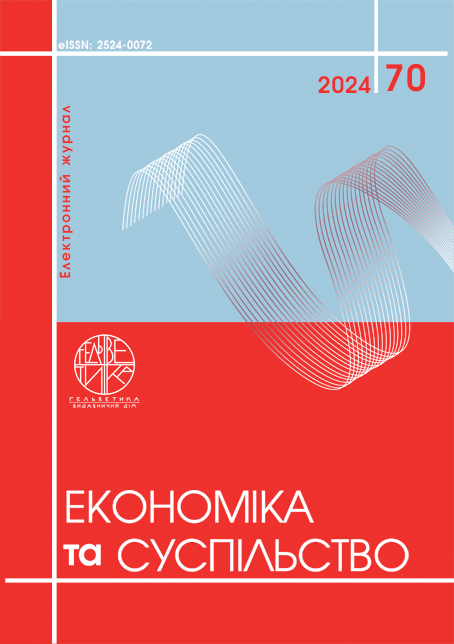MARKETING IN TELEMEDICINE: METHODOLOGICAL ASPECTS OF HEALTH CARE AVAILABILITY STUDYING IN THE MODERN HEALTHCARE SYSTEM
Abstract
The article devoted to the exploration of marketing methodologies in telemedicine focuses on ensuring healthcare availability within a patient-centered framework. It highlights telemedicine’s crucial role in overcoming barriers to health care, especially in crisis conditions, such as in Ukraine, where disrupted infrastructure and displacement have severely limited access to care. The research emphasizes mixed-method approaches, integrating qualitative methods (e.g., interviews and focus groups) with quantitative techniques (e.g., surveys and data analysis) to comprehensively analyze healthcare access. Five mixed-method research designs are discussed: explanatory (quantitative data followed by qualitative insights), exploratory (qualitative data guiding subsequent quantitative analysis), concurrent (simultaneous collection and integration of qualitative and quantitative data), integrative (deep integration of data for a holistic understanding), and embedded (one method supporting the primary focus of another). Each design is applied to telemedicine, enabling a thorough exploration of barriers, such as financial constraints or digital illiteracy, and the formulation of effective strategies. The study underscores the importance of the 7 Ps marketing mix framework (product, price, place, promotion, process, people, physical evidence) in designing telemedicine strategies for diverse patient groups. Examples include user-friendly platforms for the elderly, regional solutions for rural populations, and digital tools tailored for younger users. Patient segmentation based on socio-demographics, health conditions, and digital skills allows for targeted interventions, such as affordable services or personalized digital care. This methodological approach not only enhances the understanding of telemedicine’s role but also provides actionable strategies to improve access, promote inclusivity, and drive the digital transformation of healthcare systems. The findings call for collaboration among stakeholders to bridge gaps and achieve equitable healthcare.
References
Wootton H. (2020). Telemedicine: Economic Analysis and Global Implementation. Journal of Telemedicine and Telecare. URL: https://journals. sagepub.com/home/jtt
Kruse M. (2022). Digital Health Marketing Strategies. Health Economics Review. URL: https://healtheconomics review. biomedcentral.com/
Smith T., Wallace E. et al. (2020). Telemedicine in Rural Areas: Challenges and Opportunities. Rural Health Journal. URL: https://ruralhealthjournal.com/
Elliott P. et al. (2021). The Role of Digital Advertising in Expanding Telemedicine Access. Journal of Digital Health. URL: https://digitalhealthjournal.org/
Mehrotra A. et al. (2020). Comparative Effectiveness of Telemedicine and In-Person Care. Health Affairs Journal. URL: https://www.healthaffairs.org/
Chunara R., Zhao Y. (2022). Telemedicine Adoption: A Data-Driven Perspective. Digital Health Analytics Journal. URL: https://digitalhealthanalyticsjournal.com/
Turner M. et al. (2022). Overcoming Barriers to Telemedicine Implementation: A Framework Approach. Telehealth and Medicine Today. URL: https://telehealthandmedicinetoday.com/
Bergmo T. (2021). Cost Analysis of Telemedicine Systems in Europe. European Journal of Health Economics. URL: https://european healtheconomicsjournal.com/
Литвиненко Н. В. (2021). Економічна ефективність впровадження телемедицини в Україні. Вісник економіки охорони здоров’я. URL: https://health-economics.com.ua
Гринь О. П. (2022). Правові аспекти телемедицини: виклики та перспективи. Юридична наука. URL: https://law-science.ua
Коваленко І. А. (2023). Розвиток телемедицини в умовах цифрової трансформації України. Наукові записки Інституту охорони здоров’я. URL: https://medjournal.ua
Gabor, G. G., Marushchak M. I., & Moskalyk M. I. (2024). Marketing activity in the field of medical services. Bulletin of Hygiene and Epidemiology, (1), 45-52.
Harrison R. L., & Reilly T. M. (2011). Mixed methods designs in marketing research. Qualitative Market Research: An International Journal, 14(1), 7-26.
Creswell J. W., & Plano Clark V. L. (2017). Designing and Conducting Mixed Methods Research. Sage Publications.
Mathwick C., Wiertz C., & Ruyter K. D. (2008). Social capital production in a virtual P3 community. Journal of Consumer Research, no 34(6), 832-849.
Bryman A. (2006). Integrating quantitative and qualitative research: How is it done? Qualitative Research, 6(1), 97-113.
Johnson R. B., & Onwuegbuzie A. J. (2007). Toward a definition of mixed methods research. Journal of Mixed Methods Research, 1(2), 112-133.
Kotler P., Shalowitz J., & Stevens R. J. (2008). Strategic Marketing For Health Care Organizations: Building A Customer-Driven Health System. Jossey-Bass.
Malhotra N. K., & Birks D. F. (2007). Marketing Research: An Applied Approach. Pearson Education.
Tashakkori A., & Teddlie C. (2010). Sage Handbook of Mixed Methods in Social & Behavioral Research. Sage Publications.
Patton M. Q. (2002). Qualitative Research & Evaluation Methods. Sage Publications.
Yin R. K. (2017). Case Study Research and Applications: Design and Methods. Sage Publications.
Plano Clark V.L., & Ivankova N.V. (2016). Mixed Methods Research: A Guide to the Field. Sage Publications.
Silverman D. (2013). Doing Qualitative Research: A Practical Handbook. Sage Publications.
Dahl D. W., & Moreau C. P. (2007).Thinking Inside the Box: Why Consumers Enjoy Constrained Creative Experiences. Journal of Marketing Research. September, no 44(3). P. 357-369. DOI:10.1509/jmkr.44.3.357. URL: https://www.researchgate.net/ publication/228615196_Thinking_Inside_the_ Box_Why_Consumers_Enjoy_Constrained_Creative_Experiences/
Scott L.M., & Vargas P. (2007). Writing with pictures: Toward a unifying theory of consumer response to images. Journal of Consumer Research, 34(3), 341–356.
Flick U. (2014). An Introduction to Qualitative Research. Sage Publications.
Wootton H. (2020). Telemedicine: Economic Analysis and Global Implementation. Journal of Telemedicine and Telecare. URL: https://journals. sagepub.com/home/jtt
Kruse M. (2022). Digital Health Marketing Strategies. Health Economics Review. URL: https://healtheconomics review. biomedcentral.com/
Smith T., Wallace E. et al. (2020). Telemedicine in Rural Areas: Challenges and Opportunities. Rural Health Journal. URL: https://ruralhealthjournal.com/
Elliott P. et al. (2021). The Role of Digital Advertising in Expanding Telemedicine Access. Journal of Digital Health. URL: https://digitalhealthjournal.org/
Mehrotra A. et al. (2020). Comparative Effectiveness of Telemedicine and In-Person Care. Health Affairs Journal. URL: https://www.healthaffairs.org/
Chunara R., Zhao Y. (2022). Telemedicine Adoption: A Data-Driven Perspective. Digital Health Analytics Journal. URL: https://digitalhealthanalyticsjournal.com/
Turner M. et al. (2022). Overcoming Barriers to Telemedicine Implementation: A Framework Approach. Telehealth and Medicine Today. URL: https://telehealthandmedicinetoday.com
Bergmo T. (2021). Cost Analysis of Telemedicine Systems in Europe. European Journal of Health Economics. URL: https://europeanhealtheconomicsjournal.com/
Lytvynenko N. V. (2021). Ekonomichna efektyvnist vprovadzhennia telemedytsyny v Ukraini. [Economic effectiveness of the introduction of telemedicine in Ukraine]. Visnyk ekonomiky okhorony zdorovia. URL: https://health-economics.com.ua
Hryn O. P. (2022). Pravovi aspekty telemedytsyny: vyklyky ta perspektyvy. [Legal aspects of telemedicine: challenges and prospects]. Yurydychna nauka. URL: https://law-science.ua
Kovalenko I. A. (2023). Rozvytok telemedytsyny v umovakh tsyfrovoi transformatsii Ukrainy.[The development of telemedicine in the conditions of digital transformation of Ukraine]. Naukovi zapysky Instytutu okhorony zdorovia.URL: https://medjournal.ua
Gabor G. G., Marushchak M. I., & Moskalyk M. I. (2024). Marketing activity in the field of medical services. Bulletin of Hygiene and Epidemiology, (1), 45-52.
Harrison R. L., & Reilly T. M. (2011). Mixed methods designs in marketing research. Qualitative Market Research: An International Journal, 14(1), 7-26.
Creswell J. W., & Plano Clark V. L. (2017). Designing and Conducting Mixed Methods Research. Sage Publications.
Mathwick C., Wiertz C., & Ruyter K. D. (2008). Social capital production in a virtual P3 community. Journal of Consumer Research, 34(6), 832-849.
Bryman A. (2006). Integrating quantitative and qualitative research: How is it done? Qualitative Research, 6(1), 97-113.
Johnson R. B., & Onwuegbuzie A. J. (2007). Toward a definition of mixed methods research. Journal of Mixed Methods Research, 1(2), 112-133.
Kotler P., Shalowitz J., & Stevens R. J. (2008). Strategic Marketing For Health Care Organizations: Building A Customer-Driven Health System. Jossey-Bass.
Malhotra N. K., & Birks D. F. (2007). Marketing Research: An Applied Approach. Pearson Education.
Tashakkori A., & Teddlie C. (2010). Sage Handbook of Mixed Methods in Social & Behavioral Research. Sage Publications.
Patton M. Q. (2002). Qualitative Research & Evaluation Methods. Sage Publications.
Yin R. K. (2017). Case Study Research and Applications: Design and Methods. Sage Publications.
Plano Clark V.L., & Ivankova N.V. (2016). Mixed Methods Research: A Guide to the Field. Sage Publications.
Silverman D. (2013). Doing Qualitative Research: A Practical Handbook. Sage Publications.
Dahl D. W., & Moreau C. P. (2007).Thinking Inside the Box: Why Consumers Enjoy Constrained Creative Experiences. Journal of Marketing Research. September, 44(3). P. 357-369. DOI:10.1509/jmkr.44.3.357. URL: https://www.researchgate.net/ publication/228615196_Thinking_ Inside_the_ Box_Why_Consumers_Enjoy_Constrained_Creative_Experiences/
Scott L.M., & Vargas P. (2007). Writing with pictures: Toward a unifying theory of consumer response to images. Journal of Consumer Research, 34(3), 341–356.
Flick U. (2014). An Introduction to Qualitative Research. Sage Publications.

This work is licensed under a Creative Commons Attribution 4.0 International License.


